QuestionQUESTION: I am new at having aquariums but I have read a lot on the internet and I'm trying to learn. Unfortunately I have found so much conflicting advice that I want to ask someone directly. I bought a 16 gallon Mega BiOrb in late November. I set it up, added the conditioners (Tap Water Conditioner, Accuclear, Stress Coat and Stress Zyme and a tad bit of API Aquarium Salt as indicated). I waited 24 hours before transporting my less than 1 inch black moor into the tank. He died a few days later (I sort of expected it, he had been sick anyway) and I bought two small, about an inch not counting tails, Orandas. For three weeks they were fine, and the water has been fine. I had only cleaned the tank once, using the BiOrb cleaning cloth on the inside and doing a 30% partial water change once each week. Each time adding the required conditioners as above to the new water. Three days ago I woke up and the tank was so grayish-white murky cloudy I couldn't see to the back. The Orandas were still active and showed no signs of stress but I tested the waters. Temp stays at 74 F, Ph was 7.6 which I am told is fine for Orandas, Nitrates was 0.0 but since this is a new tank there probably hasn't been time for the ammonia to convert. The ammonia however, was 4.0! I panicked. I did a 50% water change, vaccumed the bottom of the tank for leftover food and waste and added AmmoLock as indicated on the bottle. I re-tested and it was still a 2.0 even though the water looked clearer. This was the last day they were fed. The next morning, day two, it was worse. Ammonia tested between a 4.0 and 6.0. I did a 30% water change, added AmmoLock and changed the filter cartridge since it was about 3 weeks old, even though this is early. The ammonia tested at 2.0. I noticed the Orandas have not been as active. Their fins are not clamped and they are not breathing rapidly but they aren't as active. Today, day three, the water was the absolute worst. It's gone from grayish white to yellow and it's so cloudy. The ammonia tested 6.0 this morning. I did another 30% water change and added more AmmoLock. This time the water looked a little clearer but ammonia is still testing between 2.0 and 4.0. They are even less active today. They haven't eaten in two days so that I can wait for the water to clear. When I was feeding them I was giving them NutraFin Max flake food and only as much as they would immediately gobble up. I have bought some floating pellets for when the water clears a bit. I want to do the right thing and I don't want these fish to die and I have read so many conflicting things on what to do please help!
ANSWER: Hi April,
Oh dear. I am so sorry, I had hoped these horrible fish tanks had finally gone out of vogue...ugh! I apologize for saying this, but for the money you've spent on this expensive kit, you could have bought yourself a standard 29 gallon tank which would have been the perfect home for your two orandas. These glorified bowls are completely inappropriate for keeping fish with as high an oxygen requirement as goldfish, I would only consider keeping a community of small schooling fish (such as neons, white cloud mountain minnows) or possibly a trio or quartet of female bettas, or maybe a single male betta with a snail of some sort...but definitely not a deep bodied fish.
You see, the length of the tank determines the surface area available to the life inside. A vase or a bowl is not a suitable vessel for keeping fish, not just because it is not filtered, but because of the shape. Tall tanks are practically useless, as are bowl shaped tanks, because what fish really do is swim horizontally, not vertically, and with a standard rectangular tank, the surface area is maximized. I'm not the best at explaining this, so check out this article below to understand what I mean better:
http://www.tropical-aquarium-fish.com/topics/how-aquarium-water-capacity-relates
So here's the nitty gritty, April. If you like the decorative look of your BiOrb, choose little fish that can breathe oxygen directly from the air. Bettas and paradisefish, respectively (they cannot be housed together) would be just fine. Or the shoal of tiny fish, as mentioned above. Return the two orandas, since they seem to be healthy so far, and get yourself fishes that have a fair shot of thriving in your fish tank. Or, if you love the two orandas, buy a 29 gallon tank, which is the perfect size for two of them. 10 gallons per goldfish is the absolute minimum, but the price difference between a 20 gallon and a 29 gallon is not great, and a 29 gallon is a suitable long term home for those two fancy goldfish. Add aeration (via an airstone, airline tubing and an air pump) or use a powerhead at one corner of the 29 gallon tank, and make sure the filter is strong enough. Usually the filters included with a kit are not adequate and need an additional filter to supplement it.
The only thing you can do in the interim is to keep these two fish in a container such as a Rubbermaid, the bigger the better. You are going to need some kind of water movement in there, the cheapest hang-on back filter from a place like Walmart would be fine, and these can be clipped onto the container. In the meantime, get your BiOrb cycled. Remove 100% of the water, start with fresh water. Rinse all of the gravel clean in dechlorinated water to get any goop off. You can keep the same filter cartridge. If you feed the empty tank a pinch of flake food a day (as though you were feeding a couple of imaginary guppies) then it will produce enough of an ammonia source to get the tank to cycle in a week or so. It will be cycled once ammonia and nitrites read 0 ppm, and a trace of nitrates show up. "Fishless cycling" is the process of introducing an ammonia source - either a pinch of flake daily, or a tiny piece of cocktail shrimp left to degrade in the tank continuously - that isn't fish, so that the bacteria have ammonia to feed on but the fish aren't being exposed to the toxic ammonia or unhealthful nitrite. Once a tank is cycled, nitrates will accumulate until a water change is performed. It's best not to let nitrates get over 20 ppm, and definitely not 40 ppm...
Nonetheless, I am sorry to say that if you return your two orandas to the BiOrb, even when the tank is fully cycled, you will never be able to maintain water quality at an acceptable level. Two goldfish in a standard 15 gallon tank is difficult, but in a BiOrb it's downright impossible. These tanks have to be the worst idea ever thought of! I haven't seen the packaging for these tanks - they fortunately did not catch on in my area of FL - but I bet they even have pictures of half a dozen fancy goldfish living happily inside! Well, this is absolute rubbish...if anyone can show me a picture of healthy, living fancy goldfish (or any kind of goldfish besides fingerlings or fry) living happily in this upscale bowl, I'll eat my hat! It just cannot be done.
So please, find another container to keep the orandas in for now. Make sure that the dechlorinator you are using can neutralize both chlorine and chloramine, as this is especially important. I am very fond of Prime, by Seachem, which can also detoxify ammonia in an emergency, eliminating the need for AmmoLock. The biggest boon is that the 50 mL bottle is a dropper bottle, and 2 drops per gallon is all it takes to make tap water safe for fish. Which makes water changes by the gallon ever so simple! Do look for that dechlorinator, especially the 50 mL dropper bottle size.
As you seem to know already, do not feed these goldfish as long as they are in water with ammonia in it. They won't be hungry, the food will likely sink and rot, compounding your problems. Even if they eat, what goes in must come out, so again, you're going to have an ammonia spike. I know you are doing your best, you seem like you really care about your fish, I am just sorry that you were duped into buying this awful tank with the intention of housing fancy goldfish. I can't think of any worse fish to put in this kind of tank - oscars, maybe? Goldfish have such a need for high levels of dissolved oxygen (which is why aeration and water movement is so important in a goldfish tank) that a standard sized rectangular tank is a *must*.
By the way, your pH of 7.6 is just fine for goldfish of any kind, but do make sure that you have some hardness and alkalinity to your water. Not sure if your test strips or liquid tests for this, if it doesn't, you can get it tested at the pet store. Or if you like, you can buy some 5-in-1 test strips...I use Jungle brand strips, $13 for 50 strips. With goldfish, some hardness is preferable - as long as it's not "Low" it's fine - and the big one is alkalinity. Alkalinity keeps pH stable, so it performs an important role in fishkeeping. Sometimes tap water - especially water that gets processed by treatment plants as opposed to well water - will have very low alkalinity, and this is dangerous, leaving you apt to experience lots of fluctuations in pH. Fish need stability more than anything when it comes to water chemistry. So if you should test your water and alkalinity turns out to be "Low" then there are things you can add to the water (simple baking soda, for example) to bring the alkalinity up. Let's cross that bridge when we get there...I don't want to confuse or discourage you further!
If you are looking for sources of quality fishkeeping information online, my two favorite general sites are:
http://freshaquarium.about.com
http://www.wetwebmedia.com
A site that explains everything clearly and concisely is:
http://www.firsttank.net
And lastly, a couple of excellent goldfish sites are:
http://www.kokosgoldfish.com
http://www.goldfishparadise.com
Do let me know if there's anything I can do to help. Feel free to write a nasty letter to Reef One, the makers of this awful product! Which I would have no problem with, incidentally, if it would just be advertised as a "high tech betta bowl" instead of an all purpose aquarium kit.
Take care,
Nicole
---------- FOLLOW-UP ----------
QUESTION: Thanks, Nicole, I do appreciate it. I did a 50% water change this morning adding nothing but new water and API Tap Water Conditioner and it's much better. Ammonia read 1.0 after the change. I also took the filter out and rinsed the sponge in water from the tank and cleaned out the air tube that goes up the middle. It has gotten a little more cloudy today as the day has gone on but a white cloudy, not yellow. The fish were more active today and I did feed them 4 pellets each. I watched them eat them to make sure they didn't sink (although I know it'll make no difference they ate it since they'll poop it out). I'm going to stick to feeding them to every 2 days and doing the water changes for now. Reef-One suggests 6 fantails to that 16 gallon tank. (Their is a lady on eBay selling her 8 gallon BiOrb with 6 fantails included). I knew that was too much and went with the 2 Orandas instead. I preferred smaller tropicals and would've never gotten them except I had a black moor and since goldfish are compatible only with goldfish I went with them. The Moor died the day I got the Orandas. I planned on upgrading when they got a little bigger and putting some smaller fish in the BiOrb once I moved the Orandas. I did call a friend, she has a spare 20 gallon she is going to give me for the Orandas until I can move them to a more permanent, bigger tank. I love the BiOrb and cannot part with it after spending $250+ at this point and I love Brutus and Helga, the two Orandas, I've had them for almost a month now so Petsmart wouldn't take them back anyway. How many smaller tropicals can I put in the Mega Orb? (I am getting a heater). Reef One suggests 24 small tropicals but I am guessing I can actually put much fewer in than that. Thanks, April
AnswerHi again April,
Wow, what an ordeal. It sounds like the 20 gallon solution is going to be the way to go. I know that technically it is only going to be 4 more gallons of water, but you'll be amazed how much easier that traditional tank will be to keep stable. I am glad you are so resourceful, have obviously read up, and have good instincts. A few years ago, I would have had my jaw drop at the 6 fantails comment, but now, nothing surprises me any longer. Goldfish are like the martyrs of the fish world - I don't know why so much bad advice about them is given. In the case of Reef One, it's not just ignorance but deception! Obviously, these people know that what they are saying is bunk, and who knows how many countless people do just what you did - spend a bundle on the tank, buy goldfish, realize that goldfish are untenable in that tank, and end up with small tropical fish, probably having their egos bruised along the way, feeling like they did everything wrong. If I were a lawyer, Reef One would be my pro bono class action lawsuit! What amazes me is that Reef One is a UK company, where they have stringent standards about animal welfare. Ok, well, enough ranting from me...I just had to get that off of my chest!
Keep doing the daily water changes, and your fish ought to be fine. I would recommend that other dechlorinator, Prime by Seachem, again, just because of the simple dosing and the fact that when I looked it up online, it seems to say that the API dechlorinator "breaks the chloramine bond" which worries me, since breaking the chloramine bond essentially means turning chloramine into chlorine and ammonia. At least, this is my understanding - go to Google.com and type breaking chloramine bond
And you'll see why this wording makes me a bit shaky.
What a dechlorinator ought to say is "neutralizes chlorine and chloramine" since chloramine is becoming increasingly common these days to treat municipal water. Prime by Seachem, AquaSafe by Tetra, Start Right by Jungle...these are all dechlorinators I know do this, and are all dechlorinators I have used, 1 teaspoon detoxifies 10 gallons of water. It's very possible that your API water conditioner is doing its job fine, but the prospect of possibly adding extra ammonia to your tank would be enough to make me run out and buy a different dechlorinator. I've used a few API products - API General Cure is the cheapest form of Metronidazole I've ever been able to find, and it's very effective for treating bloat and parasites, API's Melafix and Pimafix are OK as a form of very mild medicine, not exactly efficacious when treating for real illness, and API's AmmoLock is helpful when doing things like moving or shipping fish, just add a few drops to the bag and it really helps to keep the water stable during transport - however in general, this is another company I have a bit of distrust for. Seachem makes excellent products, both freshwater and marine, and Tetra also makes quality products and foods.
As far as how many tropical fish you can have in the BiOrb, what kind of fish are you interested in? It's hard for me to say, since some tropical fish - such as mollies - look small but won't do well in a relatively little tank, since they are active swimmers and sensitive to nitrate. Platys might do fine in your tank, but if you get any females, they'll have babies and before you know it, you'll have tons of fry to deal with! So platys wouldn't be my first recommendation for that reason. Also, what kind of water chemistry do you have in your region of the US (or the world)? Hard and alkaline water is essential for livebearers to thrive. If indeed your water is hard and alkaline, there are fish such as danios and cherry barbs that would prefer soft water but can adapt to hard water without ill effects. Cardinal and neon tetras are tricky fish that can adapt to hard water but do much better in soft water, their colors won't usually glow in hard water, and since people usually buy these colorful fish for their neon effect, it can be disappointing if their water is not suitably soft.
As you can see, it gets complicated picking out fish when you think about it! So why don't you investigate your water chemistry, and then consider fish you would like to see in your 16 gallon BiOrb...and then feel free to write back.
Good luck with everything, and thanks for writing. Happy holidays to you, if I don't hear from you right away.
Nicole
P.S. Since you seem interested in goldfish keeping, I thought I would share this article with you. It just came out in this month's issue of Practical Fishkeeping magazine!
http://www.wetwebmedia.com/FWSubWebIndex/goldfish101art.htm

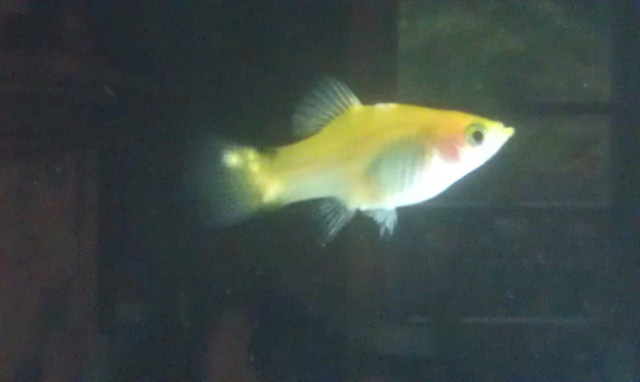 Large white patches
Question
Yellow Platy with spot
Ive had this fem
Large white patches
Question
Yellow Platy with spot
Ive had this fem
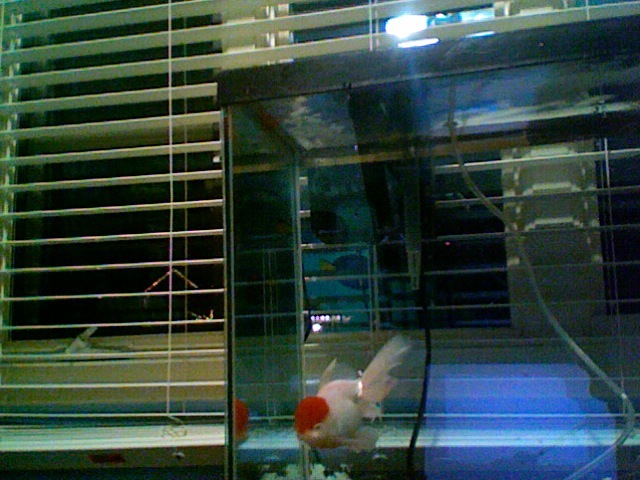 My new Oranda
Questionoranda
QUESTION: My new Oranda has Red S
My new Oranda
Questionoranda
QUESTION: My new Oranda has Red S
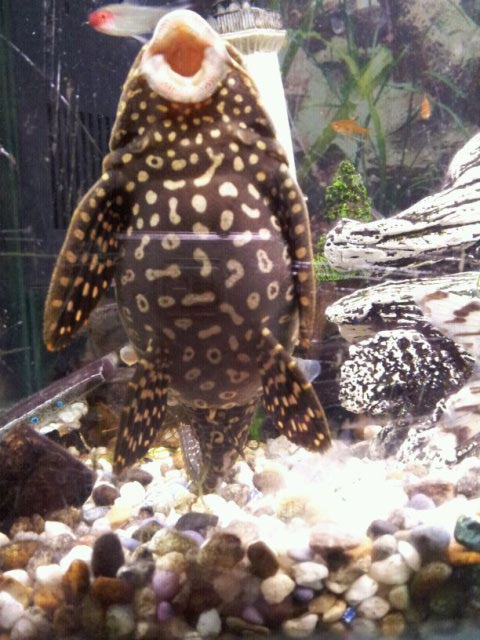 Bloated Pleco; Bubbley skin
QuestionPleco
Pleco
QUESTION: My Common P
Bloated Pleco; Bubbley skin
QuestionPleco
Pleco
QUESTION: My Common P
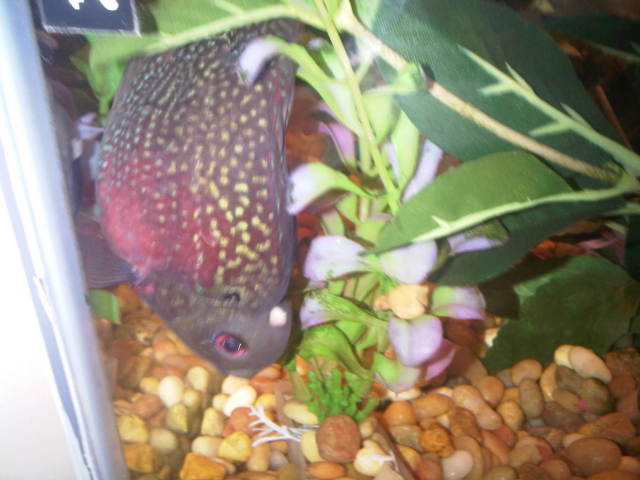 Parrot Fish - White Spot
Question
Fish Spot
Hi Ms. Fields,
I have 3 parro
Parrot Fish - White Spot
Question
Fish Spot
Hi Ms. Fields,
I have 3 parro
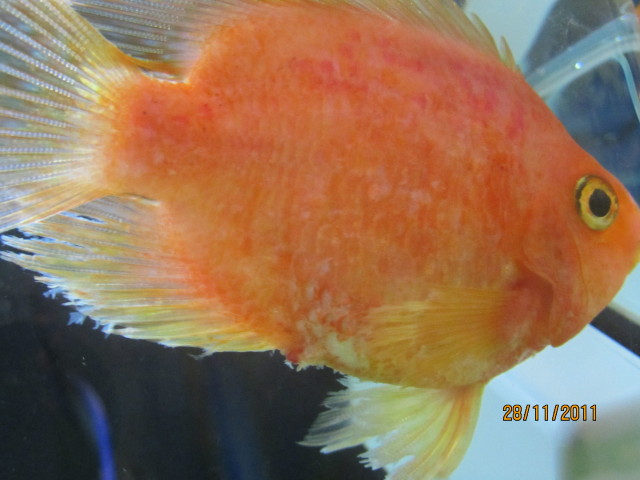 parrot fish disease
Question
parrot fish
i find out today the skin o
parrot fish disease
Question
parrot fish
i find out today the skin o